Cooperativity Study guides, Class notes & Summaries
Looking for the best study guides, study notes and summaries about Cooperativity? On this page you'll find 176 study documents about Cooperativity.
Page 2 out of 176 results
Sort by
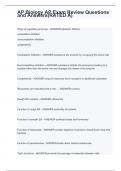
-
AP Biology AP Exam Review Questions and Answers(RATED A)
- Exam (elaborations) • 10 pages • 2024
-
- $10.39
- + learn more
Ways of regulating enzymes - ANSWER-allosteric effector competitive inhibition noncompetitive inhibition cooperativity Competitive inhibition - ANSWER-substance the enzyme by occupying the active site Noncompetitive inhibition - ANSWER-substance inhibits the enzyme by binding to a location other than the active site and changes the shape of the enzyme Cooperativity - ANSWER-enzyme becomes more receptive to additional substrates Ribosomes are manufactures in the... - ANSWER-nucleus...
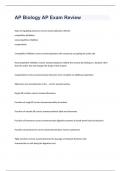
-
AP Biology AP Exam Review with verified solutions
- Exam (elaborations) • 9 pages • 2023
-
Available in package deal
-
- $14.49
- + learn more
Ways of regulating enzymes allosteric effector competitive inhibition noncompetitive inhibition cooperativity Competitive inhibition substance the enzyme by occupying the active site Noncompetitive inhibition substance inhibits the enzyme by binding to a location other than the active site and changes the shape of the enzyme Cooperativity enzyme becomes more receptive to additional substrates Ribosomes are manufactures in the... nucleus Rough ER contain...
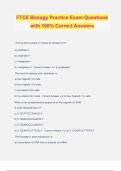
-
FTCE Biology Practice Exam Questions with 100% Correct Answers
- Exam (elaborations) • 32 pages • 2024
- Available in package deal
-
- $13.49
- + learn more
FTCE Biology Practice Exam Questions with 100% Correct Answers During which phase of mitosis do tetrads form? a) prophase I b) prophase II c) metaphase I d) metaphase II - Correct Answer ️️ -a) prophase I The result of meiosis and cytokinesis is: a) two haploid (1n) cells b) four haploid (1n) cells c) two diploid (2n) cells d) four diploid (2n) cells - Correct Answer ️️ -b) four haploid (1n) cells What is the complementary sequence to this segment of DNA: 5' CGTTAGGAATAC 3...
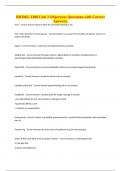
-
BIOMG 3300 Unit 3 Objectives Questions with Correct Answers.
- Exam (elaborations) • 7 pages • 2024
-
- $9.99
- + learn more
BIOMG 3300 Unit 3 Objectives Questions with Correct Answers. Fe3+ - Correct Answer doesn't allow for reversible binding to O2 Fe2+ when bound to 2 heme groups - Correct Answer can cause the formation of radicals, which are bad for the body Ligand - Correct Answer a molecule reversibly bound by a protein binding site - Correct Answer the place where a ligand binds to a protein complementary in size/charge/shape/hydrophilic/hydrophobic character induced fit - Correct Answer structura...
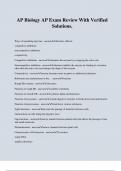
-
AP Biology AP Exam Review With Verified Solutions.
- Exam (elaborations) • 7 pages • 2024
- Available in package deal
-
- $11.49
- + learn more
AP Biology AP Exam Review With Verified Solutions. Ways of regulating enzymes - answerallosteric effector competitive inhibition noncompetitive inhibition cooperativity Competitive inhibition - answersubstance the enzyme by occupying the active site Noncompetitive inhibition - answersubstance inhibits the enzyme by binding to a location other than the active site and changes the shape of the enzyme Cooperativity - answerenzyme becomes more receptive to additional substrates Ribosomes a...
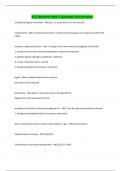
-
VCU Biochem Exam 2 Questions And Answers
- Exam (elaborations) • 9 pages • 2023
- Available in package deal
-
- $12.49
- + learn more
VCU Biochem Exam 2 Questions And Answers is binding of ligands reversible? - ANS-yes, it is essential for it to be reversible cooperativity - ANS-In multisubunit proteins, conformational changes in one subunit can affect the others functions of globular proteins - ANS-1. storage of ions and molecules (myoglobin and ferritin) 2. transport of ions and molecules (hemoglobin, serotonin transporter) 3. defense against pathogens (antibodies, cytokines) 4. muscle contraction (actin, myosin) 5....

-
Biochemistry ACS Exam Questions and Answers 2024
- Exam (elaborations) • 25 pages • 2024
- Available in package deal
-
- $16.49
- + learn more
structures and properties of amino acids Nonpolar, Aliphatic (Hydrophobic): Glycine (Gly, G) Alanine (Ala, A) Valine (Val, V) Leucine (Leu, L) Isoleucine (Ile, I) Proline (Pro, P) Aromatic (Hydrophobic): Phenylalanine (Phe, F) Tyrosine (Tyr, Y) Tryptophan (Trp, W) Polar, Uncharged (Hydrophilic): Serine (Ser, S) Threonine (Thr, T) Cysteine (Cys, C) Methionine (Met, M) Asparagine (Asn, N) Glutamine (Gln, Q) Positively Charged (Basic, Hydrophilic): Lysine (Lys, K) Arginin...
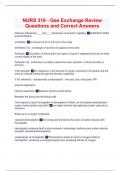
-
NURS 316 - Gas Exchange Review Questions and Correct Answers
- Exam (elaborations) • 11 pages • 2024
- Available in package deal
-
- $9.49
- + learn more
Diffusion affected by ___ and ___ (thickness) of alveoli to capillary SURFACE AREA and DISTANCE Ventilation movement of air in and out of the lungs Ventilation (V) - exchange of alveolar air (gaseous flow rate) Perfusion Circulation of blood within an organ or tissue in adequate amounts to meet current needs of the cells. Perfusion (Q) - pulmonary circulation (blood flow rate; quantité = French quantity or amount) V/Q mismatch An imbalance in the amount of oxygen received in the alveoli an...
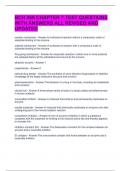
-
BCH 369 CHAPTER 7 TEST QUESTIONS WITH ANSWERS ALL REVISED AND UPDATED
- Exam (elaborations) • 4 pages • 2024
-
Available in package deal
-
- $12.79
- + learn more
BCH 369 CHAPTER 7 TEST QUESTIONS WITH ANSWERS ALL REVISED AND UPDATED random mechanism - Answer-A multisubunit reaction without a compulsory order of substrate binding to the enzyme. ordered mechanism - Answer-A multisubunit reaction with a compulsory order of substrate binding to the enzyme. Ping pong mechanism - Answer-An enzymatic reaction in which one or more products are released before all the substrates have bound to the enzyme. allosteric enzyme - Answer-1 cooperativity - A...

-
BMSC 200 - Module 5 || with 100% Error-free Solutions.
- Exam (elaborations) • 7 pages • 2024
-
Available in package deal
-
- $10.49
- + learn more
Ligand correct answers A molecule which is reversibly bound by a protein; A small molecule that binds specifically to a larger one; for example, a hormone is the ligand for its specific protein ligand. Induced Fit correct answers Proteins or enzymes may undergo conformational changes when a lignand binds which alters the function of the protein; What do Myoglobin and haemoglobin contain? correct answers They contain a hem prosthetic group which binds oxygen. What does Heme consist of? c...

How did he do that? By selling his study resources on Stuvia. Try it yourself! Discover all about earning on Stuvia


